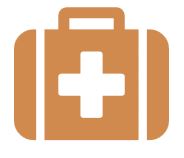Priority Issue: Behavioral Health
Promoting social and emotional wellness for all
Access to health services directly impacts the overall physical, social, and mental health status of a community. When administered and delivered appropriately and in a timely fashion, health services— including primary, behavioral, oral, and specialty care services — help prevent disease and disability, detect and treat health conditions, improve quality of life, avoid preventable death, and increase general life expectancy.

Related Key Indicators
Goal 1: Reduce key social-emotional risk factors associated with behavioral health issues.
Objective 1.1: Implement an awareness campaign to reduce stigma surrounding behavioral health issues.
Identify best practices for the development and implementation of stigma-reduction campaigns.
Mobilize resources that focus on stigma reduction in at-risk populations or for specific behavioral health issues and treatments.
Disseminate campaign resources to support implementation.
Objective 1.2: Reduce social isolation by promoting a sense of connection, belonging, and meaning.
Identify at-risk populations and indicators for social isolation.
Promote best practices in mentoring and develop strategies to recruit mentors.
Promote community environmental design strategies that foster connection and engagement.
Disseminate programmatic resources aimed at reducing social isolation.
Objective 1.3: Promote the development of effective stress management and coping skills.
Increase community awareness of the causes and impacts of stress and healthy behaviors that support well-being and resiliency.
Promote natural and built environmental design strategies that foster mental health and wellness.
Goal 2: Reduce environmental risk factors associated with behavioral health issues.
Objective 2.1: Increase community awareness of behavioral health services.
Complete website for information and navigation on behavioral health resources for adults.
Expand participation in trainings to help people recognize individuals in distress, understand available resources, and facilitate help-seeking behaviors.
Objective 2.2: Decrease access to lethal means of suicide.
Provide training and information to firearm owners and sellers about identifying suicide risk, promoting safe storage, and removing access to lethal means for those at-risk.
Promote safety planning to providers and families in behavioral health care settings for individuals at risk of suicide.
Objective 2.3: Reduce access to alcohol, tobacco, and other drugs.
Provide ongoing education, assistance, and support to community members on secure medication storage and disposal.
Educate families on measures they can take to reduce minors' access to alcohol and other substances.
Implement retail-based efforts to raise awareness of alcohol and tobacco laws and reduce use by minors.
Explore policy opportunities to prevent vaping initiation.
Develop and promote resources for parent-to-parent conversations about substance use.
Inform legislative efforts to expand local taxing authority and limit the availability of tobacco products.
Objective 2.4: Minimize exposures to secondhand smoke and vapors.
Promote tobacco cessation programs and supports.
Increase community awareness of vaping products and its risks.
Expand the number and locations of Tobacco-Free Zones, and update signage to address vaping.
Support policies that restrict the use of tobacco and vaping products in public areas.
Provide technical assistance and support to multi-unit housing complexes and neighborhoods on implementing smoke-free policies.


